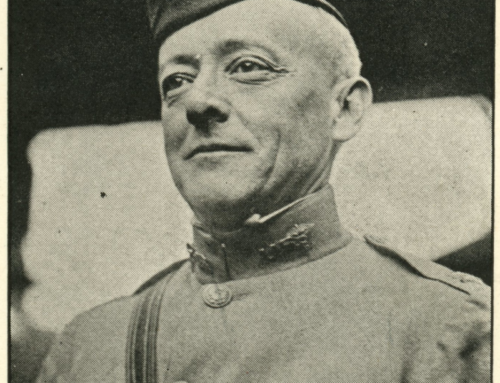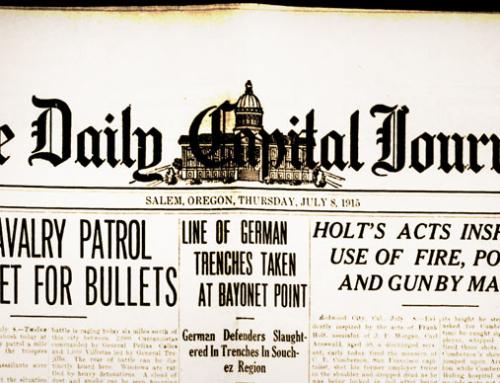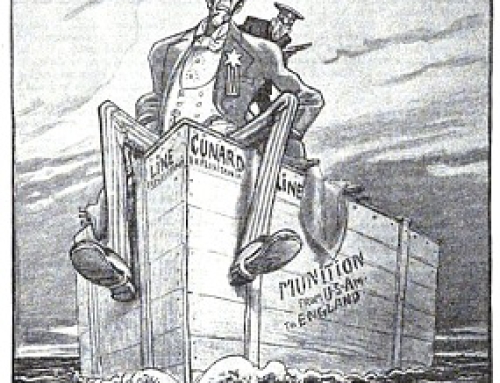by Richard van Pelt, WWI Correspondent
On Wednesday the ninth of the month, the front page of the Capital Journal reported that “Upwards of 6,000,000 men were estimated here today to be actually fighting in France, eastern Germany, Russian Poland and Austrian Galicia.”
The war headlines graphically describe battles that would soon reduce to the bitter sauce that would be the trench warfare of the coming years:
DASH LIKE BREAKERS ON BEACH
Fighting of Most Desperate Character and Losses Are Simply Appalling
SPLENDID SOLDIERS SACRIFICED IN VAIN
Germans Inflict Enormous Damage But Fail to Break Allies Lines
OUTLOOK IS BAD FOR AUSTRIANS
Claim Made the Slav Soldiers Shoot Their Austrian Officers in the Back
EPIDEMIC DECIMATES, FAMINE THREATENS
One Ray of Light in Gloom — Servians Checked and Driven Out of Bosnia
TURKS IN ALBANIA MAY FORCE ITALY INTO THE CONTEST
Italy Wanted Albania at Close of Balkan War, But Was Shut Out Of It
IT WOULD PLACE HER IN CONTROL OF ADRIATIC
When Kinglet William of Wied Quit Turks Quietly Took Possession
SO FAR NO DECISIVE RESULTS
Great Battle at End of Third Day Results Only in Long Death List
CLAIM GERMANS HAVE EVACUATED ALSACE
And that Two Main Armies Have Been Withdrawn From France
“Graphic Story of First Airship Fight” read the headline describing the use of air power in war. Reporting from Berlin, via The Hague, Karl Von Wiegand writes:
At Liège . . . I saw the chief actor in the first actual “battle in the air,” Sergeant Werner, of the German army aviation corps, who piloted Lieutenant Von Heidsen on his flight over Paris.
“The men who hold the reserved seats in the theater of this war and who see the battles as not even the generals see them,” said Werner, “are the aviators.
“I owe it to Providence that a I am alive today.”
The Bird and the Eagle
“[Lieutenant Von Heidsen] suddenly . . . pressed my arm and pointed upward.
“Looking where Von Heidsen pointed, I saw 1,000 feet above us, a big Bristol biplane, speeding toward us.
“I tried to climb, realizing that the biplane would drop a bomb as soon as it was directly above and destroy us.
“But I failed. I could not reach the biplane’s level.
“Soon it was directly overhead.
“I was not afraid, but it was a moment of suspense such as to take years out of one’s life.
“The biplane’s speed was regulated so as just to keep pace with us as it swept lower and lower.
“I learned then how a bird feels with an eagle or a hawk swooping upon it.
“The biplane evidently was trying to get so close that a bomb could not miss us.”
A Pistol Duel
“My nerves were unstrung. Suddenly I saw a flash beside me and thought for a moment that a bomb had struck us.
“Then I realized that Lieutenant Von Heidsen was firing at the biplane with his automatic pistol.
“The biplane’s propellor was in front so that those in it could not fire from that direction. Then it became certain that it carried no bombs. Instead, it veered aside and opened fire.
“Simultaneously we plunged northward toward the German lines.
“Accurate shooting was impossible because of the speed at which we were moving, but one bullet struck our plane.
“It was evident that the Englishmen were trying to disable our motor, as we were trying to do with theirs.
“So far as we were concerned, we felt helpless, our machine was so much slower and more unwieldy.
“Suddenly the lieutenant touched my arm again, and pointed to a spot thousands of feet above us. There, approaching at tremendous speed, was a small Bleriot monoplane.”
ENEMIES LEAVE THEM
“It looked like an eagle to the attack.
“I felt certain that the end was near.
“The Bleriot was even speedier than the Bristol, but it also was without bombs, and those in it had to depend on pistols.
“Sweeping and circling the Bleriot kept firing at us, Von Heidsen answering the shots quite calmly.
“Suddenly German troops appeared below and began firing at the enemy. The Bristol and the Bleriot, their ammunition exhausted, disappeared to the southward.
“We landed safely bearing an extremely valuable report.
“But I don’t want a similar experience again.”
This prompted the following editorial:
DAREDEVILS OF AIR
Evidently there is one branch of the military service in each of the armies engaged in the European conflict that actually rejoices and revels in the latitude the war provides and which peace would to a large extent prohibit. This is the aero branch, which seems to be permitted to attempt whatever fearing exploits suggest themselves.
Though there has been expressed considerable disappointment at the apparent ineffectiveness of efforts at assault from the upper air, the aeroplanes and dirigibles having suffered loss entirely disproportionate to the amount of damage wrought on the several objectives, the armies have not lost faith in their aerial forces and expect great things tone accomplished by them before the hostilities are ended.
It is by all agreed also, that the feats of daring daily being accomplished by airmen demonstrate great intrepidity which often amounts to foolhardiness. Some of the dangerous flights over enemies’ cities seem to have been made in the spirit of pure bravado, as little, if any, advantage was to be gained thereby. Thus we have German air craft sailing over Ostend and Paris, and French aviators circling Brussels, each dropping notes of encouragement or warning and each in constant peril at the hands of hundreds of sharpshooters. One of the flyers is reported to have even “looped the loop” in the full sight of and quite within the range of the enemy.
These demonstrations, however, do not constitute service in any effective sense and the airmen must learn to better direct their energies if they expect to become a factor of significance in bringing out results desired by the forces under whose flags they operate.







Leave A Comment